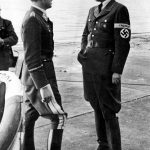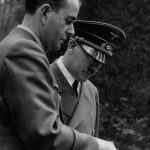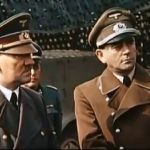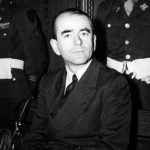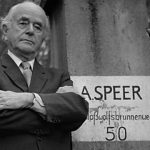Albert Speer
19.03.1905 – 1.09.1981 German Architect, Minister of Armaments and Production for Nazi Germany
He was the only major Government minister of the Third Reich to plead guilty to the charge of war crimes during the Nuremberg Trials of 1945-46, for which he was given a 20-year sentence, instead of a death sentence. Born in Mannheim, Germany, he studied architecture in Karlsruhe and Munich, receiving his architectural license in 1927. In late 1930, he heard Hitler speak at a Berlin rally, and joined the Nazi Party in January 1931, for which his architectural firm was awarded with construction contracts for leading party members.
In 1933, he was awarded the contract to construct Joseph Goebbels’ official residence, and in 1934, the Nuremberg Stadium in support of the official celebrations of the Nazi’s rise to power. His efficiency and talent attracted Hitler’s attention, and he later became a close friend of Der Fuehrer, enjoying a relative freedom of action that other members of Hitler’s entourage never had. In return, Speer gave Hitler total loyalty and dedication. In 1935, he drew up a plan for the reconstruction of Berlin, creating large (and in some people’s eyes, megalomaniac) massive building plans. In 1937, Hitler personally appointed Speer Inspector General for Construction for the Reich. When Fritz Todt died in an airplane accident in 1942, Speer succeeded him as Minister of Armaments and War Production.
Using forced and slave labor, Speer was able to increase armaments production to an incredible quantity, while dispersing his factories to lessen their destruction from allied bombing. Using his personal friendship with Hitler, he was able to avoid problems from other Nazi leaders. Towards the end of the war, Hitler ordered Speer to destroy all factories, city utilities (water and electricity), and transportation means (railroads and bridges). Recognizing these would be needed in the post-war Germany, Speer began countermanding Hitler’s orders for complete destruction. He would visit field commanders, arguing to spare a historic bridge or other important building, arguing that it would be “recaptured in the inevitable counterattack”, and thus avoiding charges of defeatism (this charge was punishable by death).
After the war, Speer was placed on trial at the International Military Tribunal in Nuremberg for war crimes of employing slave laborers. Breaking from other top Nazi defendants, Speer pleaded guilty, and was sentenced to 20 years in Spandau prison.
Upon his release in 1966, Speer published his memoirs, “Inside the Third Reich” (1970), considered the best portrait of conditions inside the Nazi hierarchy. (bio by: Kit and Morgan Benson)
 English
English polski
polski
